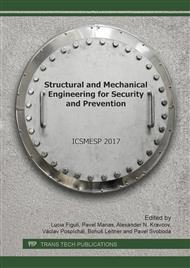[1]
A. Fanfarová, L. Mariš, A. Osvald, E. Mikkola, The reaction to fire tests for natural thermal insulation of hemp material modified by fire retardant ohnostop special, in: Communications, scientific letter of the University of Žilina, Žilina, Slovak Republic, 2015, vol. 17, issue 1, pp.15-21.
DOI: 10.26552/com.c.2015.1.15-21
Google Scholar
[2]
L. Mariš, Risk management in selected international standards of project management, in: Security technologies, systems and management, Zlín, Czech Republic, 2013. ISBN 978-80-7454-289-3.
Google Scholar
[3]
A. Osvald, J. Štefko, J. Flachbart, J. Svetlík, Š. Rástocký, The model fire of two-story wooden building, in: Materials for construction, Springer Media, Praha, Czech Republic, 2012, vol. 18, issue 7, pp.50-53. ISSN 1213-0311.
DOI: 10.26552/krm.c.2012.2.36-41
Google Scholar
[4]
L. Makovická Osvaldová, S. Gašpercová, The evaluation of flammability properties regarding testing methods, in: Civil and environmental engineering, scientific technical journal, De Gruyter Open, Warsaw, Poland, 2015, vol. 11, no. 2, pp.142-146.
DOI: 10.1515/cee-2015-0018
Google Scholar
[5]
Information on http: /www. proficolor. sk/ drevostavby8. html.
Google Scholar
[6]
Information on http: /www. ohnostop. com/ ohnostop-special. html.
Google Scholar
[7]
A. Fanfarová, Methodology for testing the fire retardants and retardant modifications of materials - Reaction to fire tests, internal document of University of Žilina, Faculty of Security Engineering, Department of Fire Engineering, Žilina, Slovak Republic, (2014).
Google Scholar
[8]
V. Kavický, L. Figuli, Š. Jangl, Z. Zvaková, Analysis of the field test results of ammonium nitrate: fuel oil explosives as improvised explosive device charges, in: Structures under shock and impact XIII, Southampton, Boston, United Kingdom, WITpress - WIT transactions on the built environment, 2014, vol. 141, pp.297-309.
DOI: 10.2495/susi140261
Google Scholar
[9]
M. Vandlíčková, Efficiency of active fire protection systems, in: Safety engineering - fire, enviroment, work environment, integrated risk, book of proceedings, Visoka technička škola strukovnich studija, Novi Sad, Serbia, 2014, pp.183-188.
Google Scholar
[10]
L. Mariš, A. Veľas, Possibilities of using of software tools in the security projects, in: Securitologia = Securitology = Sekjuritologija - czasopismo nauk o bezpieczeństwie, Krakow, Poland, 2013, vol. 17, no. 1, pp.144-152. ISSN 1898-4509.
Google Scholar


